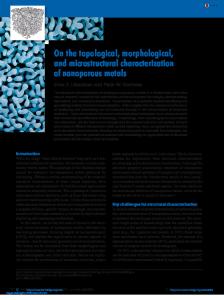Surface Stress Effects on the Elastic Behavior of Nanoporous Metals
- PDF / 385,468 Bytes
- 6 Pages / 612 x 792 pts (letter) Page_size
- 55 Downloads / 432 Views
0900-O12-33.1
Surface Stress Effects on the Elastic Behavior of Nanoporous Metals D.A. Crowson, D. Farkas and S.G. Corcoran Materials Science and Engineering Department, Virginia Polytechnic Institute and State University, Blacksburg, VA 24061 ABSTRACT Atomic scale computer simulations were used to investigate the surface stress induced deformation in nanoporous metals. A phase field model was used to generate digital nanoporous structures that are quantitatively similar to those created experimentally via dealloying. We analyze the important effects of surface relaxations on the macroscopic deformation in these samples as well as in small spherical clusters. INTRODUCTION Nanoporous metals with a bi-continuous metal-void structure can be formed by an alloy corrosion process known as dealloying corrosion[1]. Recent work in the area of dealloying has been centered on utilizing this selective dissolution process to form nanoporous structures in which the size scale of the porosity and the distribution in pore sizes can be tailored by controlling the processing conditions[2]. The size scale of the porosity can be varied from 5 nm50 µm by controlling the processing conditions and through post dealloying heat treatments[3]. The fine scale of the porosity in these materials results in very high surface area to volume ratios. Recent work has shown that nanoporous samples formed by dealloying can exhibit chargeinduced reversible strain amplitudes (>0.1%) comparable to those of commercial high-modulus piezoelectrics (0.1-0.2%)[4]. The strains are generated by adding or withdrawing charge at the surfaces electrochemically. This causes a change in the surface stress thus introducing a strain in the material. There is a need to understand how variation in surface stress results in macroscopic strain in these structures and what factors control the magnitude of the strain. In this paper, results of atomistic simulations using embedded atom method (EAM) [5] potentials will be presented that describe the effect of surface stress variation on the strain in these nanoporous structures. SURFACE STRESS AND EAM POTENTIALS The surface stress ( f ) is a thermodynamic quantity which quantifies the energy needed to create new surface area by straining an existing surface while the surface free energy quantifies the creation of new surface area by a process such as cleavage[6]. In the isotropic case, the surface stress, f, is given by ∂γ f =γ + (1) ∂ε where γ is the surface free energy. Surface stress values of gold were experimentally determined by Mays [7]. In this method, gold nuclei of varying size were deposited onto an amorphous carbon substrate by evaporation. Assuming that the nuclei are spherical with an isotropic surface free energy, the hydrostatic pressure, ∆P, acting on the nuclei due to the surface stress is given by the Laplace-Young equation.
0900-O12-33.2
2f (2) r where r is the radius of the nuclei. The hydrostatic pressure induces an elastic deformation given by Hooke’s law, (3) ∆P = −3Kε . The combination of these two
Data Loading...











